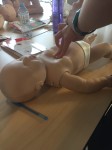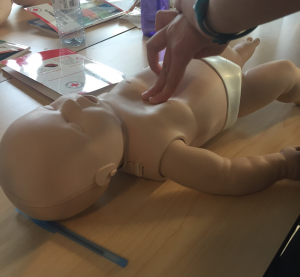With Christmas only a couple days away here is a list of the Top 10 most likely First Aid Scenarios Santa could encounter on his big night.
- Burns: Sliding down so many chimneys there is a good chance he could end up with a burn or two. Remember first aid for burns includes cooling for at least 10-15 minutes and be sure to cover loosely with a clean dressing once cooled.
- Choking: Eating that many cookies that quickly in one evening has the potential for choking as well as a pretty big belly ache. First aid for choking includes alternating between two of the three following if the blockage is complete: 5 Back blows, 5 Abdominal thrusts, 5 Chest thrusts. If you are choking alone, move yourself to somewhere you may be found, call 911, and try to dislodge to object by using a solid object like table or chair.
- Head and neck injuries: Parking a sled on a snowy, icy rooftop sounds like a recipe for falling off. If you hear a loud thud in the middle of the night and go out to find Santa laying in your front yard remember to keep him still, support his head and neck if needed and call 911.
- Animal bites: Whether it is one of the reindeer or a protective dog or cat, possible Santa could get a few nips and bites along the way. Let bites bleed for a bit to cleanse the wound, then wash with clean water and cover the wound. You may need to follow up with further medical attention and watch for infection.
- Bone, Muscle, Joint injuries: Snow, ice and moving so quickly all night, possible to jolly big dude could tweak or pull something along the way. Remember R.I.C.E. but if it is really bad call 911 and keep them still.
- Food Poisoning: We all think we are great cooks but lets be honest, some of us can’t cook to save our life. If you suspect food poisoning or any other form of poisoning give poison control a call at 1-800-268-9017.
- Cold Emergencies: Yes even Santa is vulnerable to cold related emergencies. We will summarize this with warming slow and actively. Stop heat loss, start heat gain.
- Alcohol Intoxication: If you are anything like me you have likely left beer for Santa at some point. Now imagine how many pints Santa could end up drinking during that one night. If you happen to find him passed out drunk, please Check ABC’s, Call 911, Place him in the recovery position and monitor his condition.
- Hyperventilation: Imagine looking at your watch and only having a few hours left to deliver a few billion gifts, you may get a little worked up as well. Remember hyperventilation can often be resolved by coaching the individual to control their breathing. Using your hands up and down provides great visual for them to follow.
- Heart Attack: I don’t mean to judge but I feel Santa’s lifestyle definitely does increase the risk of a heart attack. All those cookies and all that stress. If you suspect heart attack, Call 911, consider Aspirin and Nitro, and monitor condition while gathering relevant information including symptoms and past history.
 Honorary Mention:
Honorary Mention:
Allergic Reactions: I have no idea if Santa suffers from any form of allergy but if he does he is definitely at great risk of having a reaction. Severe Allergic Reactions should be dealt with an auto- injector (Epi-pen or Allerject) and call 911. About 20% of people will have a second reaction.
Diabetic Emergency: No idea if Santa is Diabetic or not but all those cookies must not help his case. Diabetic emergencies are managed with sugar (lots of options available). If it does not improve in ten minutes, more sugar and call 911. Never put sugar in an unconscious person’s mouth.




 Heat Cramps: Like the name indicates, muscle cramps and severe spasms often in the legs and abdomen caused by loss of fluids and electrolytes typically caused by exercise and sweating. First aid guidelines include:
Heat Cramps: Like the name indicates, muscle cramps and severe spasms often in the legs and abdomen caused by loss of fluids and electrolytes typically caused by exercise and sweating. First aid guidelines include: Heat Stroke: Is a life threatening condition in where the body’s internal cooling mechanisms begin to fail and are overwhelmed. The body stops sweating because internal fluid levels are too low which causes a rapid increase in internal core temperature. Essentially the body begins to cook up on the inside. Vital organs begin to fail and unconsciousness, seizures and even death are all possible if not immediately dealt with. Initial indicators include red, hot dry skin, irritable bizarre behaviour, rapid noisy breathing. Immediate first aid measures include:
Heat Stroke: Is a life threatening condition in where the body’s internal cooling mechanisms begin to fail and are overwhelmed. The body stops sweating because internal fluid levels are too low which causes a rapid increase in internal core temperature. Essentially the body begins to cook up on the inside. Vital organs begin to fail and unconsciousness, seizures and even death are all possible if not immediately dealt with. Initial indicators include red, hot dry skin, irritable bizarre behaviour, rapid noisy breathing. Immediate first aid measures include:
 After the recent success of our Christmas Vacation Babysitting Courses and various PD Days in 2018 we are excited to share with you the schedule for our March Break Canadian Red Cross Babysitting Courses.
After the recent success of our Christmas Vacation Babysitting Courses and various PD Days in 2018 we are excited to share with you the schedule for our March Break Canadian Red Cross Babysitting Courses.  So what all do the participants learn?
So what all do the participants learn? It may seem like a lot of information. No need to worry though as each participant goes home with not only their certificate of completion but their own copy of the Canadian Red Cross Babysitter’s Manual. The resources section of our website also has useful links to allow the participants to continue to be successful with their babysitting jobs for years to come.
It may seem like a lot of information. No need to worry though as each participant goes home with not only their certificate of completion but their own copy of the Canadian Red Cross Babysitter’s Manual. The resources section of our website also has useful links to allow the participants to continue to be successful with their babysitting jobs for years to come. As a Training Partner with the Canadian Red Cross we are proud to run babysitting courses throughout the year all over the Ottawa area. The Red Cross curriculum is based off of learner centered teaching styles which means most learning is done through hands on activities and games instead of an instructor lecturing all day long. By having youth work in groups in a directed manor they can often learn and improve from each other’s previous experiences all while having fun with new found friends. The main objective of these babysitting courses is to build confidence as a future babysitter meaning there is no stressful exam at the end of the course. Skills learnt are beneficial well beyond simply babysitting and I would highly recommend them for any youth. As a father, a firefighter and a first aid instructor I cannot stress enough the value in taking a Canadian Red Cross Babysitting course.
As a Training Partner with the Canadian Red Cross we are proud to run babysitting courses throughout the year all over the Ottawa area. The Red Cross curriculum is based off of learner centered teaching styles which means most learning is done through hands on activities and games instead of an instructor lecturing all day long. By having youth work in groups in a directed manor they can often learn and improve from each other’s previous experiences all while having fun with new found friends. The main objective of these babysitting courses is to build confidence as a future babysitter meaning there is no stressful exam at the end of the course. Skills learnt are beneficial well beyond simply babysitting and I would highly recommend them for any youth. As a father, a firefighter and a first aid instructor I cannot stress enough the value in taking a Canadian Red Cross Babysitting course.

 Having been to an outdoor NHL game a couple of years ago not only did I have a great time but I also learnt a few valuable lessons about how to prepare for 3-4 hours sitting outside in winter weather in a stadium setting. The two things you need to be aware of here are frostbite and hypothermia. As much as you want to represent your teams colours, being warm should be your first priority.
Having been to an outdoor NHL game a couple of years ago not only did I have a great time but I also learnt a few valuable lessons about how to prepare for 3-4 hours sitting outside in winter weather in a stadium setting. The two things you need to be aware of here are frostbite and hypothermia. As much as you want to represent your teams colours, being warm should be your first priority.
 Here are some great tips the consider when hiring a babysitter for your household.
Here are some great tips the consider when hiring a babysitter for your household.